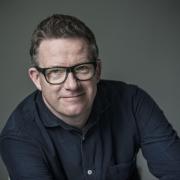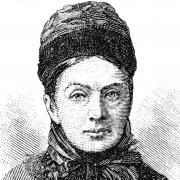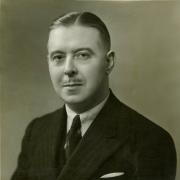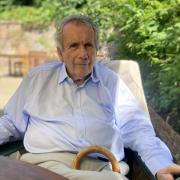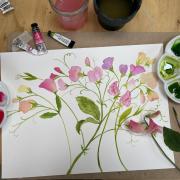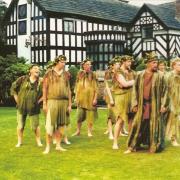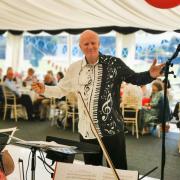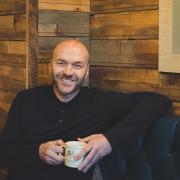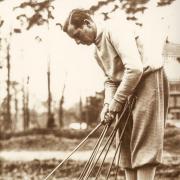Emma Rodgers creates works of art in clay and bronze and has a following that stretches from her home in Wirral to Hollywood and Singapore, from Liverpool to the far reaches of the universe. Well, the latter is only literally true should you believe The Collector's Museum, in the Marvel film Guardians of the Galaxy is a real place...
Earth-based, though still starry, her collectors include Ellen DeGeneres and Keanu Reeves. She exhibits at galleries in New York, Beirut, and across Europe and you'll find her work in the permanent collection at the Walker Gallery in Liverpool and at Collect Art, in Lymm. She’s recently been approached about undertaking a residency in Bali, which as the cold wind blows here, she’s finding increasingly tempting.

Emma has won public commissions from Salford City Council, for which she created the sculpture Salford Firsts, placed in Bexley Square and celebrating the rich history of the city; from the family of Cilla Black, who wanted to gift a statue of the iconic singer to the city of Liverpool and from not-for-profit organisation, Monumental Welsh Women, which commissioned Emma to commemorate Elaine Morgan, scriptwriter, evolutionary theorist and passionate feminist, and only the second statue of a woman in Wales. She’s also responsible for the world’s largest Liver Bird, a commission from the Derwent Group, Liverpool City Council, and Spin Master – the owner of Meccano. The bird is made with specially fabricated Meccano-style pieces to commemorate Liverpool-born toy maker Frank Hornby and the first Meccano factory, on Binns Road. It stands 11 metres tall and took Emma over a year to make.
‘I went to the Meccano factory in Calais and was like a kid in a candy shop,’ she says, ‘just going through all the standard parts thinking how I could interpret all the mass-produced pieces into a claw or a beak or a ribcage.’

Perhaps one of Emma’s proudest achievements, however, is her patronage of the Clatterbridge Cancer Charity, and the creation of Primavera, a sculpture of a tree in the sunken garden at Clatterbridge Cancer Centre, Liverpool, which will continue to change over time as she adds more elements.
‘I have been a patron of Clatterbridge Cancer Charity for 13 years now, since my mum was treated there for cancer. They were wonderful with her and getting the ‘all clear’ was a wonderful moment. They’ve done more for me than I can ever do for them, so creating the tree seems a small thing, really. It’s designed so it can spread up and out over time, and we add a dove dedicated to every fundraiser who raises £5,000 or more.’
Emma’s relationship with Johnny Vegas in part came about due to her support of Clatterbridge, as Johnny, whose father received treatment at the Wirral cancer centre, is also a major supporter of the hospital and drove fundraising to build the Liverpool site.

‘He’d asked about coming to visit me a couple of times, and then a mutual friend of ours suggested it really should happen. He got in touch and came to the foundry where I create my bronzes. I think it helped him see that any of your ideas and concepts can come to life if you have that sort of structure around you. It’s not then intimidating to think “where do I start?”. When you see what’s going on in lots of other different scales and styles and mediums, it makes you believe it’s possible to achieve what it is you want to create.’
Vegas studied art and ceramics at university, but his vision was to be a comedian – a dream he made come true, but which took him away from his art for some while. His work with Emma as his mentor has brought him back to his first love.
‘I work with Johnny almost like a technician more than anything, getting back to some practical skills. I don’t want to imprint my style on him; it’s about how he can evolve his own style and take it further. The work he was creating years ago is evolving and taking on a new lease of life. He’s really got back into his painting and drawing as well. What he’s doing is quite diverse, but if you look at some of his early work it’s as if he’s picked up his sketchbook and carried on.’


Johnny pops over for workshops with Emma between filming, and over the year of their partnership, they have moved into a very informal, relaxed approach to their sessions together.
‘We have our own way of working,’ Emma says. ‘We don’t work in the studio, which is filled with distractions. Instead, we work at my dining room table and that helps us stay on track.
‘Through us working together he also had his first exhibition in a number of years, alongside myself and two other artists, at Private and Public Gallery, in Jersey.’
As a result of her show in Jersey, Emma has been commissioned to create another large public piece, inspired by the myth of the Black Dog of Bouley Bay, which according to some tales would guide lost travellers to safety, and to others meant a storm was coming.

‘I have some ideas for this already and can’t wait to get started,’ Emma says.
Emma's understanding of the shape of animals and how they move comes from her close observation of birds and beasts in motion (Emma has, over the years, fostered sheep and a fox, kept dogs, cats, rabbits and even a hare), as well as her relationship with a local veterinary hospital.
‘If you know what’s going on under the surface, how the sinews move and how the joints move you can be much freer in your mark making. It’s like life drawing, when you have an understanding of the movement of the body it gives you a greater understanding of form. I have a relationship with Movement Referrals, a specialist veterinary clinic in Runcorn that treats animals referred with orthopaedic conditions.’
Emma met the team there following a lecture she delivered at Leahurst, a veterinary postgraduate teaching hospital. Her talk was about how she takes inspiration from nature, and they invited her to observe MRI scans and X-rays and learn how everything is put together, as well as gait studies following hip replacements, for example.

‘I find it all fascinating. If you understand how a socket moves, how an animal flows and how it all works together it’s much easier to interpret. When I create the limbs, I make them as a separate piece and add it on to the torso, and I do this with all my work – whether it’s a monkey or a human or a dog or cat.’
It’s not only the form of her subject itself that occupies Emma’s mind as she works, but the space within and around it, too, with the gaps encouraging the observer to complete the piece and finish the story themself.
‘Space is equally as important to me as the form itself, so that’s a hollow for an eye socket, or a cut line, a slit or a tear as a representation of a drawn line. Also, the space around a piece – how you position and interact the elements – can really change the dynamic within a group.

‘In my piece The Hunt, with the horses charging through, I wanted it to be almost as if you’d just caught a glance of them rushing by, so there are traces of the riders’ capes and arrows and odd hints of muted colours. The horses aren’t all fully formed or the riders – just perhaps a hand clasping at the reins for a figure, because I wanted it to retain the movement.
‘More intimate poses, such as Mother and Child are much stiller, so the detail is more refined. It’s trying to capture what’s happening in a moment in time, whether it be calm and gentle, or visceral and filled with energy.’
As well as the public commissions, Emma has a steady stream of private commissions and gallery exhibitions, and also contributes works to the Sculpture Garden at Carden Park, curated by Grant Ford, who brings together sculptures for browsing and buying from artists across the UK. Recent private commissions include a glass-topped table for a Wirral neighbour and a spectacular fountain for a local businessman, which required engineering knowledge over and above her creative vision.
‘This was really interesting to make,’ Emma says. ‘It’s in fabricated steel, cut and bent, and I needed to know the height of the pool so I could make it as if there were waterlilies floating on the surface, and then create a “corset” that lifts off to reveal a door to the mechanism. It needed a lot of maths. I worked on it at Castle Fine Art foundry, in Liverpool, where I do all my bronzes and metal pieces.’

As well as the grand, Emma weaves in smaller projects, ensuring she’s constantly in motion.
‘At the end of 2023, I worked with Robert Willis, Cilla Black’s son, to create pieces for sale to raise funds for Variety, and I’m at various stages on several other projects too. Some can take a couple of years, on others there’s a much quicker turnaround. There are some things that are constant, for quite a while in the background and there are stages to each piece where I can’t work on them. It can all seem quite sporadic, but actually, it’s quite methodical.
‘I get hyper-focused about every piece. I get as much joy from a small gallery piece as from a huge outdoor public piece, but what I really love is when I’m scaling up – how a mark from a thumb can translate into working with the whole of the flat of your hand. I really like the physical movement of making, and perhaps this partly connects to leaving those marks I’ve made to try to keep that energy. The brisk mark of a thumb can translate to the whole pressure of my arm to create the same sort of movement; it’s like a dance.’
emmarodgers.co.uk





